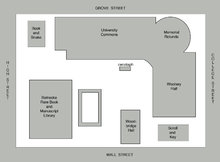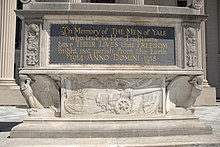Hewitt Quadrangle
This article includes a list of general references, but it lacks sufficient corresponding inline citations. (March 2017) |

Hewitt University Quadrangle, commonly known as Beinecke Plaza, is a plaza at the center of the
Buildings

Bicentennial Buildings
The Bicentennial Buildings–University Commons, the Memorial Rotunda, and Woolsey Hall–were the first buildings constructed for Yale University as opposed to one of its constituent entities (

The University Commons, simply known as "Commons" on campus, is a timber-trussed banqueting hall.
Woolsey Hall was the University's first large secular assembly hall, with 2,691 seats.[2] It holds one of the largest organs in the world: the Newberry Memorial Organ, a 1928 Skinner organ.
The Rotunda, with tablets on the walls commemorating Yale's war dead is a double-sized, domed, colonnaded version of
Woodbridge Hall
Also completed in 1901, Woodbridge Hall is the main administrative building of the university. The
Beinecke Library
The visible portion of
Sculpture

Before the colonnade of the Commons is a memorial cenotaph. Its inscription reads:
In Memory of the Men of Yale who true to Her Traditions gave their Lives that Freedom might not perish from the Earth. 1914 Anno Domini 1918.
Behind the cenotaph, one can see inscribed the names of
The Beinecke Library's sunken courtyard, visible but not accessible from the plaza, contains Isamu Noguchi's sculpture The Garden (Pyramid, Sun, and Cube). The three marble sculptures represent time, the sun, and chance. Alexander Calder's sculpture Gallows and Lollipops stands on the plaza. The Claes Oldenburg sculpture Lipstick Ascending on a Caterpillar Tread (now located in Morse College) was once on the plaza.
Use
As the symbolic heart of the university—and as the space in front of the administration building—Beinecke Plaza is occasionally the site of rallies and protests. These have included labor rallies held by the
References
- ^ Kelley 1974, pp. 318.
- ^ a b c Pinnell 1999, pp. 115.
Bibliography
- Ossman, Laurie; Ewing, Heather P. (2011). Carrère & Hastings: The Masterworks. Photographs by Steven Brooke. ISBN 978-0-8478-3564-5.
- Pinnell, Patrick (1999). The Campus Guide: Yale University. ISBN 978-1-56898-167-3.
- Carroll, Richard C., ed. (1979). Buildings and Grounds of Yale University. New Haven: Yale University.
- Kelley, Brooks Mather (1974). Yale: A History. JSTOR j.ctt32btbf.
- Holden, Reuben A. (1967). Yale: A Pictorial History.

